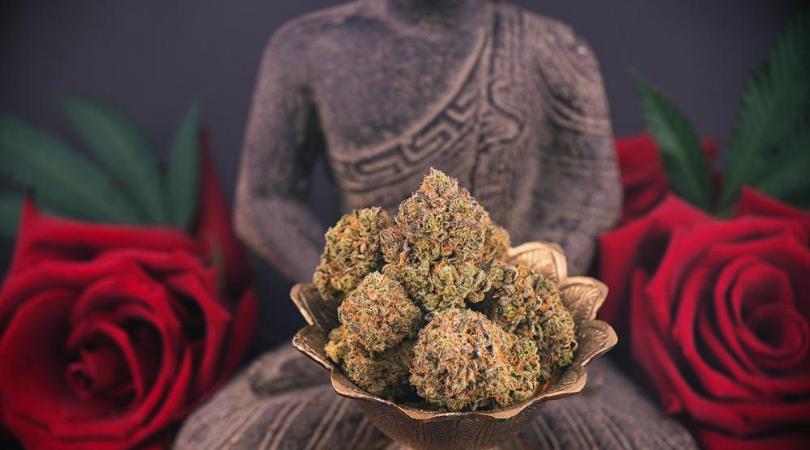Cannabis
Spiritual Uses of Marijuana Throughout History
When you think of cannabis, you might think of it as being more of a modern substance. However, people throughout civilization have used the plant for thousands of years for spiritual reasons. One of the reasons is that the herb can induce new spiritual understanding and insights. It is still used by many religious cultures. There are many reasons for this.
Throughout history, people have used various substances to alter their minds and help them search for enlightenment, meaning, and purpose. Along with magic mushrooms, hallucinogenic brews, and sacred cacti, marijuana is still used by different cultures around the world. It has an important role in many religions and faiths. Keep reading to find out how various cultures have chosen to use weed.
Marijuana for Spiritual Use
There are many spiritual uses of cannabis, and this is most likely because of the active component in it, THC. When you consume it, it can cause many different effects, such as euphoria, a sense of well-being, and relaxation. Different civilizations have used cannabis since the third millennium B.C. Their goal was to help with meditation, ceremonies, and rituals. Even today, some spiritually aware people have chosen to take advantage of the effects of cannabis. Some people believe that regularly using cannabis may lead to spiritual enlightenment if they use it often enough.
Taoism and Cannabis
The earliest use of marijuana for religion is in Taoism, which is an ancient belief system in China that goes back to around the fourth century B.C. The basic belief of Taoism is that everything in the universe exists in balance and harmony. The yin and yang symbols symbolize this.
The early texts in Taoism have mentioned that marijuana was used to burn incense for rituals. One of the reasons it was used was to have a natural state and to eliminate any selfish desires. It was believed that marijuana could also help with divination. Shaman and Taoist priests used weed to speak with both evil and good spirits.

Scythians and Weed
The Scythians were a group of people that came from central Asia, which is the area that is now called southern Siberia. These people were good at archery and were travelling warriors that rode horses. But they also enjoyed having a good smoke every now and then.
According to the Greek historian known as Herodotus, the Scythians used marijuana in an ingenious manner. They would create a temporary structure that looked like a tent. They would then put the herb on very hot stones and bathed in the resulting smoke.
It is not known if they did this as a form of cleansing, a spiritual practice, or both. However, it was said that the Scythians would yell with their joy as they inhaled the smoke that came from the weed. This suggested that it was about more than just getting clean.
Some evidence has been found that the Scythians revered marijuana, and the seeds of the cannabis plant were discovered at their burial sites in leather pouches. It is believed that the Scythians may have introduced cannabis to Europe in the first place.
Not much is known about how cannabis was used spiritually in Europe. The Europeans believed that cannabis was used as a medicinal herb primarily. However, it also was a part of Norse paganism and linked with a goddess of fertility, beauty, and love.
The Middle East and Cannabis
Marijuana was first linked with the Zoroastrians, who were a religious group that came from Persia before the Islamic faith. The Zoroastrian sacred text is the Avesta, and it mentions cannabis, calling it the good narcotic.
The ancient Assyrians were from an area that is now parts of the modern countries of Turkey, Iraq, Syria, and Iran. It was reported that the Assyrians used weed for incense, and books from the seventh century B.C. have made references to the herb. The Jewish Talmud also mentions that cannabis had euphoric properties.
In the 11th century, the use of marijuana was becoming more widespread around the Middle East. Different Islamic mystics called Sufi used it, and the book “1,001 Arabian Nights” also mentions cannabis. One reason that the herb is so popular is that there were many Muslims. They used cannabis instead of alcohol because they were not allowed to use alcohol under the existing Islamic law.

Hinduism and Marijuana
In Hinduism, there are several ancient Vedic Scriptures, and the Atharvaveda is one of them. It is at least 3,000 years old now. The Vedas says that marijuana is one of the five plants that was considered sacred, and they believed that it had a guardian angel in the leaves. The Vedas said that the herb was a source of happiness for those who believed in it. It was believed that cannabis was a liberator and a giver of joy that could help to eliminate fear and delight the senses of humans.
In Hinduism, it is believed that Shiva made cannabis from his body so that life could be purified. This resulted in the name angaja, which means body born. That is most likely where cannabis’s name ganja came from.
In Hinduism, there are three kinds of cannabis that are used in spiritual practices. Hindus use bhang, which is made from the buds and leaves of weed and is somewhat milky. Charas is made from resin and is a kind of hash. Finally, ganja is the bud that you smoke. It is believed that bhang weed milk can purify and cleanse the body for religious festivals. This is considered to be a holy act.
Buddhism and Cannabis
Many Buddhist practitioners live in Tibet, south of the Hindu believers. The Buddhist people have used cannabis for religious purposes for a long time. Gautama Buddha established the religion in the fifth century B.C., and it is said that he only consumed one hemp seed each day while he was on his way toward becoming enlightened.
Sometimes, a traditional Buddha is shown as holding marijuana leaves. It was believed that using this plant could heighten someone’s awareness during prayer and ceremonies. Many people used it as an aid while they meditated.
The Old Testament and Cannabis
It was very common to use marijuana in ancient eastern religions, and the use was widespread. However, there was not as much evidence when it comes to marijuana and Christianity. But that changed in the early 20th century. A Polish etymologist published a new interpretation of the texts of the Old Testament in 1936.
She believed that there was a mistranslation from the original Greek version of the Old Testament, which would cause several religious texts to have a new meaning. She wrote that in Hebrew, the word for cannabis was kaneh bosm, but it was mistranslated as being calamus, which was used to make fragrances. If this is the case, then books such as Jeremiah, Song of Songs, Exodus, Ezekiel, and Isaiah all talk about weed many different times.
It is believed that King Solomon, a biblical king, was associated with cannabis. He had great knowledge and wisdom. Legends state that people found cannabis growing on his grave many years after he had died.

Ancient Greek Religions and Cannabis
Herodotus was a Greek historian who lived from around 484 to 425 B.C. and wrote about cannabis being used during Greek religious ceremonies. He wrote that the Scythians used incense from the hemp plant using tripods or containers over open flames. The partakers of the ceremony would gather in their tents and inhale the smoke during rituals. It is believed that the ancient Assyrians also used incense from the marijuana plant to keep evil spirits away and during their funerals.
Paganism and Weed
In Norse mythology, the hemp plant had energy in it from the goddess Freyja, who was responsible for beauty, fertility, and love. They believed that using the plant would allow the essence of Freyja to enter someone’s body.
There is some evidence that cannabis and hemp were both used during the early years of Germanic paganism. Both fertility and spiritual rituals made use of the plant, and it was such an important part to them that hemp seeds and clothing were given to the dead. Even harvesting marijuana caused a celebration among the people.
Rastafari Religion and Weed
In the 1930s, the Rastafari religion was developed in Jamaica. It involves using cannabis spiritually for many different ceremonies. According to their belief system, cannabis can make you take more pleasure in life while removing negative energies and making you more conscious. This is important to their belief system since they reject oppression and materialism. The Rastafari religion believes that using cannabis can get them closer to the creator, who is Jah.
After the religion had been around for a few years, their use of marijuana was scrutinized. Only after many legal proceedings was it found that cannabis was legal for religious and spiritual purposes in the United States. This caused the Religious Freedom and Restoration Act of 1993 to be established.
Other Religious Movements and Cannabis
The use of marijuana for religious and spiritual purposes is several thousand years old, many new age and modern movements have been formed in the past century and use marijuana as a sacrament. Some of the movements include Temple 420, THC Ministries, Cantheism, Green Faith Ministries, The Free Marijuana Church of Honolulu, the Church of the Universe, and the First Church of Cannabis. In 2017, a nonprofit organization known as Elevation Ministries opened its headquarters in Denver, Colorado, and is known as the International Church of Cannabis.

How to Meditate with Weed
By themselves, both marijuana and meditation have fairly similar effects. But when you combine them, you will find that the effects are amplified. Plus, it is fairly easy to combine the two, so why not? You might find that it offers both mental and spiritual benefits for you. If you approach cannabis correctly, you can make your mind quieter and experience the spiritual side of cannabis for yourself.
Look for an indica strain, which can help you feel sedated more than a sativa strain can. That can help you to reduce mental distractions and help you concentrate better. Be ready to slip into your meditation as soon as you start being affected. You can vape or smoke as long as it makes you feel restful.
Focus on your breathing. If you are just starting, that can be a challenge since you might discover that your mind is active. To prevent distractions, think about each breath you are taking. If you still feel distracted, don’t feel bad. By bringing your mind back to a more focused state, you can create better mental habits. Acknowledge your thoughts and let them come and go. Focus on your breathing for as long as you are comfortable.
You should have a goal in mind each time that you meditate, whether you want to feel calmer, lighter, or have better mental resilience and focus. The longer that you spend practicing, the easier it will be for you to benefit from this practice.
Today, many religions still use cannabis for yoga and meditation. For example, in Buddhism, cannabis is used for meditative rituals, so the participants have a better awareness.
Closing Thoughts
Using weed is nothing new, and it has been used in religious aspects of life for thousands of years. Because of the THC in its buds and leaves, cannabis can offer psychoactive effects that can help you with spiritual realization. One reason it is so popular may be because it can lead your thoughts to new heights while helping you to feel more spiritual.
Whether you choose to use marijuana for recreational, medicinal, or religious purposes, or a combination of them, it is an extraordinary herb. The next time you take a hit, think about the spiritual aspects of marijuana and how it has withstood the test of time.


